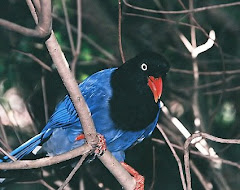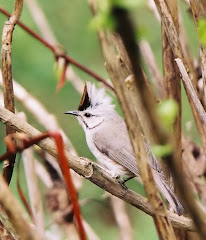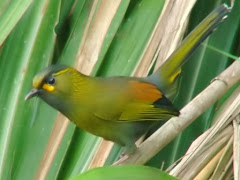 Grey Faced Buzzard: courtesy of Richard Yu
Grey Faced Buzzard: courtesy of Richard Yu The fall [October] Grey-faced Buzzard migration through Southern Taiwan is amongst the world's largest raptor migrations. In late March and early April Grey-faced Buzzard return and are a reasonably common site in Central-West Taiwan as these birds make their way to roost on Baguashan in Changhua County.
A Brief History of Grey-Faced Buzzard Conservation in Taiwan
The sight of a raptor soaring has inspired mankind through the ages. Nations, armies, corporations, and sports teams have all used the image of a raptor to symbolize their power and strength. Somehow the very sight of a raptor on the wing stirs something deep within us. It is the image of power and the very essence of a predator. It moves effortlessly and with absolute grace. It soars on high, above all, swooping down to kill in an awesome climax of noble grace, cunning speed and ruthless power. To many the eagle and its allies are indeed the ultimate predator and the personification of man’s desires incarnate.
These very virtues of the raptor have put it in direct competition with man and that conflict has played out over the ages in a number of ways and has almost always, if not always, spelt destruction for the free spirit of these noble creatures.
Man has captured raptors to make use of their skills. They have been destroyed when they have competed with us for food; poisoned and hunted when they have taken our livestock. Their feathers have been collected to decorate our costumes and in Taiwan they have fallen victim to those that wish to capture and possess their spirit.
At the southern tip of Taiwan lies the Heng-chun Peninsula. The Heng-chun Peninsula is the most important site for raptor migration in East Asia and is included in the 20 largest raptor migration sites globally. The Heng-chun Peninsula is the Veracruz of East Asia. Twenty-six species of diurnal raptors have been recorded to date with figures as high as 50 000+ birds passing through the peninsula in a day during the peak autumn migration period.
From early to mid October thousands of Grey-faced Buzzards Butastur indicus pass through Heng-chun, Kenting National Park in one of the earth’s most spectacular displays of avian migration. The following is a brief history of the plight and conservation of the Grey-faced Buzzard in Taiwan.
The distribution of the Grey-faced Buzzard is the Eastern Palearctic region with the species wintering in the Indomalayan region. Through its range the species is uncommon and declining but locally abundant on passage. The Grey-faced Buzzard Butastur indicus forms a superspecies with Grasshopper Buzzard-hawk Butastur rufipennis (Afrotropical), Rufous-winged Buzzard-hawk Butastur liventer (Indomalayan) and White-eyed Buzzard-hawk Butastur teesa (Indomalayan).
The species breeds in Japan, Korea, Manchuria and Eastern Siberia. Their winter range includes Southern China, South-East Asia, the Philippines, Celebes and New Guinea. There appear to be two populations. The first population group being found on Japan and the second on mainland Asia. The Japanese population migrates through the Ryukyu Islands and Taiwan to winter in the Philippines. The second population moves south into Southern China and South-East Asia to winter. There is some indication that small numbers of Russian and Manchurian birds also use the island route to winter in the Philippines. Current estimates are that the Japanese population totals about 32 000 pairs with their young of the year.
As the Japanese population moves south in autumn, they enter Taiwan in large flocks in the north-eastern part of the island and follow the eastern side of the north-south mountainous spine of the island. They fly south following mountainous ridges and roosting in river valleys. At the southern tip of Taiwan they pass through the Heng-chun Peninsula in large numbers in the second week of October and often roost close to Man-chou Village (sometimes spelt Manjhou). In the spring they tend to follow the western foothills of the central mountain range northwards in small groups and gather in fairly large numbers from mid to late March in the Baguashan area, Chunghua County, West-Central Taiwan.
Historically, the greatest threat to the Grey-faced Buzzard in Taiwan has been the uncontrolled hunting of the species in the Baguashan and Heng-chun Peninsula areas. Hunting and trapping of Grey-faced Buzzard in the Baguashan and Heng-chun Peninsula areas has gone on for generations. It seemed that locals originally hunted them as a source of food. The species was known to migrate over long distances and it was believed that they must possess great stamina and strength. Even the Chinese common name bears reference to its migration. The species is commonly called “Nan-lu Ing” which translates to “South Road Eagle.” The species began to be seen as a type of “tonic food” that would impart the attributes of strength and stamina to those that ate it.
It would appear that the species was never really hunted to sell as a “tonic food” but rather as what was seen as a traditional “precious gift” to be given to family and friends.
During Taiwan's Japanese colonial period (1895-1945) very little was known about the status of the species in Taiwan. Hachisuka & Udagawa in their Contribution to the Ornithology of Formosa published in 1951 describe only three known specimens taken from Taiwan. It is very clear that the scientific community was not aware that the species migrated through Taiwan in large numbers in the early fifties. By the mid 1960’s the Migratory Animal Pathological Survey (MAPS) * bird banding team was aware of a large migration of Grey-faced Buzzard through Taiwan and that Man-chou villagers on the Heng-chun Peninsula were hunting them but the extent of this hunting was not known and was of little concern. During this period there was a change in the reason for hunting the species. The focus shifted from food to specimens. There was a demand for specimens from the local tourist trade and a growing market in Japan.
The virtues of raptors and the qualities they represent are admired in Japan. The practice of keeping mounted raptors had been a long standing tradition in Japan. A raptor mount was believed to bring prosperity and good fortune into the life of the owner.
With little or no control and a culture of utilizing wildlife resources unchecked, the hunting of raptors for skins to export to Japan grew alarmingly in the late 1960s and continued through the 1970s. To a lesser extent raptors were still hunted and trapped for food, Chinese medicine, falconry, sport and mounts for the local market and tourist trade.
The Grey-faced Buzzard is seldom hunted on the wing. Generally two methods are used to trap or hunt the species in Taiwan. The first method is to put up attractive long bamboo roosting poles with a foot snare in the known area of the roost during the day. In the late afternoon when the Grey-faced Buzzards descend to roost they get caught in the snares. This was the general method used in the Baguashan area. The second is to watch where the Grey-faced Buzzards descend to roost and once darkness falls, to go into the roost area and stun the birds with a spotlight and shoot them with a crossbow like weapon or, in more recent times, a type of gas charged air gun. This method was generally used on the Heng-chun Peninsula. It is known that an experienced hunter can take seventy-eighty Buzzards in a single night.
Between 1976 and 1977, sixty-thousand Grey-faced Buzzard skins were shipped to Japan. Records also show that during the period 1978-1979, another thirty thousand skins were exported to Japan. Grey-faced Buzzards were not the only raptors being hunted. Crested Serpent Eagle Spilornis cheela, Besra Accipiter virgatus, Chinese Sparrowhawk Accipiter soloensis, Crested Goshawk Accipiter trivirgatus, Oriental Honey-Buzzard Pernis ptilorhynchus, Osprey Pandion haliatus, Mountain Hawk Eagle Spizaetus nipalensis, and Common Kestrel Falco tinnunculus were also being hunted and shipped to Japan.
 Grey Faced Buzzard: courtesy of Richard Yu
Grey Faced Buzzard: courtesy of Richard Yu The first real report of the desperate plight of the species was published in Echo magazine in1979. The report covered the October 1978 hunting of the species around Man-chou village. This was the starting point for the fight to save the species.
The report generated a lot of interest and concern over the hunting of the species. The publicity lead to feelings of hostility by the hunters in Man-chou towards concerned and interested outsiders. The president of the Taipei Bird Club coordinated a meeting in an attempt to ease tensions between the hunters and concerned individuals.
Out of these tensions, Taiwan’s first informal coalition of environmentalists, birders, NGOs and some relevant government agencies was born. At the same time the Japanese also made inquiries over the specimen trade. In August 1978, the Director of the Wild Bird Society of Japan had come to Taiwan to investigate the specimen trade between Taiwan and Japan. His report blamed Japanese specimen traders for providing the incentive for the large-scale hunting of the species in Taiwan.
Pressure was mounting and awareness was growing. In October 1979 a seminar sponsored by the Animal Protection Society was held in Kenting. There was great media interest in the seminar. The seminar lead to the establishment of the Migratory Bird Protection Program.
The media and performing arts played a very important role in creating awareness. National Day is 10 October. As the height of the Grey-faced Buzzard migration falls approximately on the same date, the Grey-faced Buzzard became known as the National Day Bird. This type of publicity coupled with education and awareness campaigns started to have an impact. Reports such as “To protect the eagles at Man-chou” (Wild Bird 1. 1980) by conservationist John Wu Sen-hsiong really highlighted the plight of the species. John Wu Sen-hsiong featured very prominently in the conservation effort and would go on to write the highly regarded “A Field Guide to the Wild Birds of Taiwan” which was published in 1991. Much of his story can be read in Kate Rogers’s “The Swallows’ Return.”
In 1981 the Construction and Planning Administration (CPA) within the Ministry of the Interior was established and tasked with the setting up of Taiwan’s national park system. The same year also saw the establishment of Kenting National Park, Taiwan’s first national park. The establishment of the park as a protected area was a major boost for the conservation effort and would mark the start of a decade of growing legal protection for the species. Another milestone was the hosting of the second East Asian Bird Protection Conference in Kenting National Park in 1983 which placed Taiwan’s conservation efforts under an international spotlight.
Through the efforts of concerned individuals and groups in Taiwan, Japan, and internationally, the plight of the Grey-faced Buzzard continued to be tackled into the next decade. Continuous awareness was raised through ongoing education programs. Activities promoting the conservation of the species were held at schools and temples in the area. The government was persuaded to issue postage stamps and mint coins depicting the Grey-faced Buzzard and Brown Shrike Lanius cristatus** to help raise awareness of the plight of migrating birds.
The Wild Bird Society of Japan and other concerned organizations successfully brought about legislation in Japan that effectively put an end to the importation of raptor skins and the demand for Taiwan’s Grey-faced Buzzard skins faded.
After the close of the Japanese market in the early eighties it appears that the trapping of live raptors for falconry and sale to raptor fanciers increased greatly. Raptors being hunted for sport also increased but overall the levels of hunting were decreasing substantially.
The 90s dawned with the species enjoying full protection from hunting. The efforts of the Wild Bird Society of ROC, now called the Wild Bird Federation Taiwan, and the Conservation Club of Chung Hsing University were very notable. Apart from their actual conservation efforts, these organizations along with many concerned individuals supplied academics like Dr Sheldon R. Severinghaus and Dr Lucia Liu Severinghaus with information needed to study the species and make informed suggestions on how best to conserve it. Indeed, Dr Lucia Liu Severinghaus’s paper “The Status and Conservation of Grey-Faced Buzzard-Eagles and Brown Shrikes Migrating Through Taiwan” (ICBP No. 12. 1991) is very valuable reading for anyone interested in conservation in Taiwan.
Conservation efforts continued into the nineties. In the early 1991 the Wild Bird Society of Chunghua was established. The new society played a vital role in the protection and monitoring of Grey-faced Buzzards during the spring migration period in the Baguashan area of Chunghua County. The Baguashan Birdfair was established as an annual event in March 1991 and promoted raptor watching in the area. The society also did much to raise local awareness through education programs.
 Grey Faced Buzzard: courtesy of Richard Yu
Grey Faced Buzzard: courtesy of Richard Yu The efforts to end the hunting of the species have been largely successful. The story of the effort to save the Grey-faced Buzzard is one that Taiwan can truly be proud of. Today, raptor watching has become a major activity in Kenting and Baguashan. Thousands flock to Kenting every October to watch the raptors passing through. In March the raptor viewing station on Baguashan is packed with raptor lovers. The conservation of the Grey-faced Buzzard in Taiwan stands as an example to the rest of Asia as to what can be achieved when people come together and work to change a culture of exploitation of a species. It clearly shows that attitudes can be changed.
Sadly, some hunting still continues in secret. Lin Wen-horn of the Raptor Research Group of Taiwan and author of “A Field Guide to the Raptors of Taiwan” (YLib, Green Pocket. 2006) estimates that about fifty hunters are still active. This shows that there is still work to be done. Education and awareness must continue and the law enforcement agencies must continue to enforce the law. It is also known that the species is hunted in the Philippines and the Ryukyu Islands.
The sight of thousands of Grey-faced Buzzard and Chinese Sparrowhawk passing through Kenting National Park and Baguashan Scenic Area each year is truly wondrous. Taiwan is indeed blessed to host such awe inspiring natural events. With this blessing comes responsibility and that is to ensure that these noble creatures are given safe passage through Taiwan on their journey to other lands. The migration of birds is the earth’s only truly unifying natural phenomenon. It binds the nations and the continents of the world together in a way that nothing else does and gives a shared responsibility to all of mankind that it is preserved.
By Mark B. Wilkie
----------------------------------------------------------------------------------
Notes
* Migratory Animal Pathological Survey (MAPS)
“This bird banding project was a result of an initiative by the United States military and related agencies to investigate possible links between the movements of migratory birds and seasonal outbreaks of various zoonoses (e.g. haematozoa) throughout the Palearctic region, including South Korea, Japan, Okinawa, Hong Kong, Taiwan, The Philippines, Thailand, Malaysia, Singapore, and India. The eight-year Migratory Animal Pathological Survey program was initiated in 1963 in Japan by the US Military.”
Rebecca L. Holberton, Department of Biology, University of Mississippi, on the book, Migration and Survival of the Birds of Asia.-H. Elliott McClure. 1998.
**Brown Shrike Lanius cristatus
Barbecued Brown Shrike was considered a local delicacy and was also being trapped in large numbers.
Also see:
Huben Birding Stories
Birding in the Huben-Hushan Area (Fairy Pitta)
Birding in Yunlin County
Huben-Hushan Bird List
Threatened Birds of the Huben-Hushan area
Fairy Pitta Gallery
Taiwan Bird Books
References
Birdlife International. (2004). Important Bird Areas in Asia. Key Sites for Conservation. Wakefield, UK, H.Charlesworth & Co.
Chun Sheng. (1979). Night Hunting at Man-chou. Echo Magazine, No 5, p84-87. ROC. (In Mandarin)
Ferguson-Lees et al. (2001). Raptors of the World. Helm, London.
Hachisuka, M & Udagawa, T. (1951). Contributions to the Ornithology of Formosa Part II. Quarterly Journal of the Taiwan Museum. Vol. IV.
Lin, W.H. (2006). A Field Guide to the Raptors of Taiwan. YLib, Green Pocket.
Taipei, Taiwan. (In Mandarin)
Liu. et al. (2005). Birdwatching in Taiwan. Wild Bird Society of Taipei. Taipei, Taiwan.
McClure, H.E. (1974). Migration and Survival of the Birds of Asia. SEATO Medical Project. Bangkok, Thailand.
MacKinnon, J & Phillipps, K. (2000). A Field Guide to the Birds of China. Oxford, Oxford University Press, UK.
Raptor Research Group of Taiwan: Chen, S.C. (2004/2005) Raptor Watch in Kenting National Park. Kenting National Park Headquarters, Pingtung, Taiwan.
Rogers, K. (2005). The Swallows' Return. A foreigner's history of birdwatching, conservation and culture in Taiwan. TESRI, Taipei, Taiwan.
Severinghaus, L.L. (1991). The status and conservation of Grey-faced Buzzard-eagle and Brown Shrike migrating through Taiwan. ICBP Technical Publication No.12.
Wu, S.H. (1980). To protect the eagles at Man-chou. Wild Bird 1. ROC.
Wu, et al. (1991). A Guide to the Wild Birds of Taiwan Taipei, Taiwan Wild Bird Information Centre and Wild Bird Society of Japan. (In Mandarin)
Websites
http://calbears.findarticles.com/p/articles/mi_qa3793/is_199910/ai_n8859738/pg_1
http://www.birdingintaiwan.com/contact%20us/Simon_Liao.htm
http://elibrary.unm.edu/sora/Auk/v116n04/p1125-p1126.pdf
Acknowledgements
A big thank you to Lin Wen-horn of the Raptor Research Group of Taiwan for his valuable input and to photographer Richard Yu of Formosa Birding for the use of his photographs. Also, to author Kate Rogers [The Swallows' Return] and her husband Derrick Wilby for all their help and to Ann Chaplin for her continued help and support in securing information in the UK for me. Finally, a very special thank you to Dr. [Scott] Lin Ruey-shing of the Taiwan Endemic Species Research Institute for his ongoing help and support in this and many other projects.
Back to Threats and Issues.







No comments:
Post a Comment